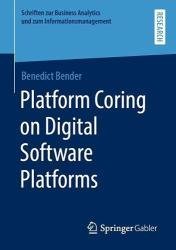 Название: Platform Coring on Digital Software Platforms
Название: Platform Coring on Digital Software PlatformsАвтор: Benedict Bender
Издательство: Springer Gabler
Год: 2021
Страниц: 262
Язык: английский
Формат: pdf (true), epub
Размер: 10.1 MB
Digital software platforms such as iOS or Android evolve quickly. Through regular updates, their set of built-in (core) functionalities increases significantly. Innovation in terms of introducing new functionality allows developers to strengthen the platform amidst competition. However, it can hurt contributors in the platform ecosystem when introducing core features that are already provided by third-party developers, which is referred to as platform coring.
So far, platform coring remains underexplored and is not sufficiently understood to provide meaningful guidance for the parties involved. Thus, this thesis addresses the research gap to better understand the phenomenon of platform coring and related implications. The combination of four studies provides insights into the stakeholder perspectives, which are integrated with theoretical findings to provide a comprehensive understanding of platform coring.
The thesis reveals coring to be a common phenomenon on software platforms. Third-party developers perceive platform coring differently, whereby their motivation to contribute is the key factor. The effects of coring for contributors depend on the type of coring performed. In general, affected applications are used less after coring. Third-party developers use countermeasures to prevent coring if it is perceived negatively and considered as likely to happen to their contributions. Platform owners are well-advised to carefully consider the benefits and risks for their platform ecosystem. Thereby, the thesis contributes by highlighting avenues to employ platform coring for the competitive advantage of the platform and ecosystem simultaneously
Digital software platforms such as iOS or Android evolve quickly. Through regular updates, their set of built-in (core) features increases. While innovation allows strengthening platforms amidst competition, it can hurt contributors when introducing core features that are already provided by third-party developers (Platform Coring). This chapter provides an introduction and overview of the coring phenomenon and related challenges for the platform owner.
Software platforms, as a specific type of innovation platforms, allow for the integration of external innovation capability within a uniform platform architecture. Following Tiwana a software platform is understood as “extensible codebase of a software-based system that provides core functionality shared by the modules that interoperate with it and the interfaces through which they interoperate”. Through the open paradigm of software platforms, third parties can contribute functionality in the form of capsuled modules. Software platforms are primarily regarded as innovation platforms “which consist of technological building blocks that are used as a foundation on top of which a large number of innovators can develop complementary services or products”. In contrast to transaction platforms that facilitate transactions and exchange among participants, the aspect of extensibility and external innovation is key. Thereby, software platforms offer users more functionality than a single entity could achieve alone. The platform owner (e.g. Apple) provides basic functionality through the platform core (e.g. iOS), whereas third-party developers provide more specialized functionality through software applications (e.g. WhatsApp) that are typically distributed over platform-specific marketplaces (e.g. AppStore). Platform users combine the core functionality with selected third-party modules to configure the platform corresponding to their individual needs.
Скачать Platform Coring on Digital Software Platforms